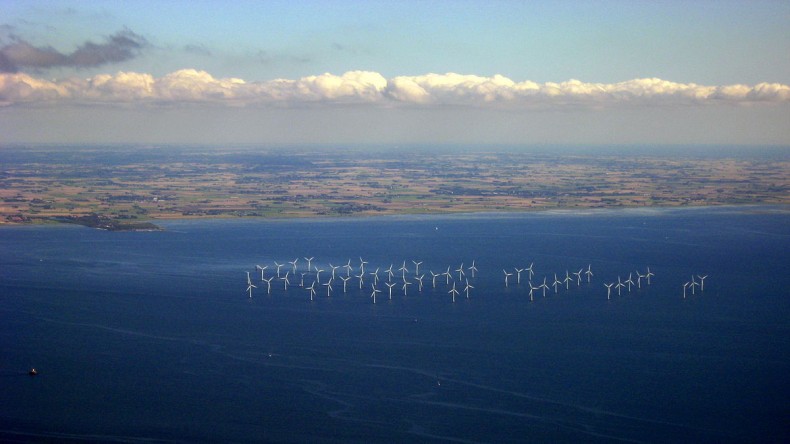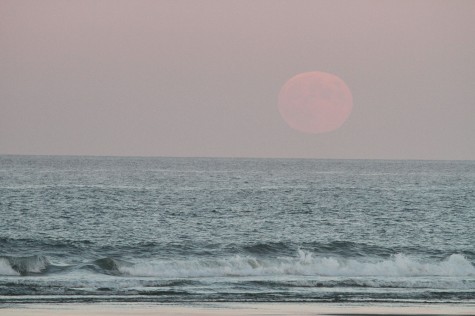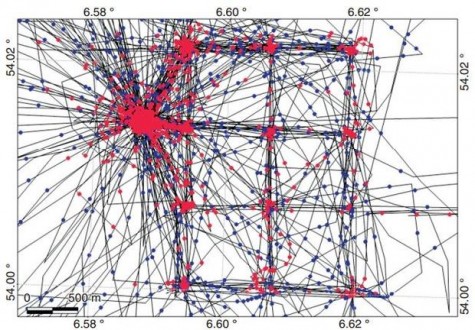 Where do you fall on the issue of wind farms at sea? Tidal energy generators? Artificial reefs? Mooring fields? Glass bottles? Old piers? Shipwrecks? Are they junk to be cleared away or are they habitat to be protected? How are they to be categorized, and at what stage in their “useful” lives do they become useless, or vice versa?
Where do you fall on the issue of wind farms at sea? Tidal energy generators? Artificial reefs? Mooring fields? Glass bottles? Old piers? Shipwrecks? Are they junk to be cleared away or are they habitat to be protected? How are they to be categorized, and at what stage in their “useful” lives do they become useless, or vice versa?
A new study published in Current Biology deepens the mystery. Titled “Marine mammals trace anthropogenic structures at sea,” it describes how researchers put GPS tracking devices on North Sea harbor seals (Phoca vitulina) and gray seals (Halichoerus grypus) in Britain and the Netherlands. They wanted to see how these high-level predators interacted with offshore wind farms in the area while they were foraging.
The North Sea has vast arrays of wind farms. A list on Wikipedia shows that the earliest array was put up in 2002 and by 2013 there were roughly 802 turbines spread across the waters of the UK, Belgium, Denmark, the Netherlands, Germany and Norway. Some are only 1.6 km from shore while others are 32 km from the beach. Excluding the deep outlier Hywind array in Norway, they are in an average of 16 m of water (range: 0 – 45m). That’s a lot of infrastructure spread through just the kind of water in which small marine mammals love to forage.
The US doesn’t have acres of sea studded with wind turbines… yet.
Where I live, on Cape Cod in Massachusetts, offshore wind farms are a hot topic of debate. They are proposed. They are advocated for. They are protested. Are they a viable alternative source of energy? Is the harm to migratory birds too great a risk? I’ve heard fishermen say that the vibrations of the pillars will impact squid migration and, thus, the movements of other species targeted by fisheries. Biologists express concern about the impact of wind farm installation noise on fish and marine mammals. But, until this article, the idea of how the farms might become part of the underwater environment has seemed absent from discussion.
Seals, too, are a hot topic on Cape Cod. Are there too many? Are they ruining precarious fisheries or attracting sharks or fouling popular  beaches? Are they a sign of an ecosystem returning to health after decades of depletion? After being nearly extirpated by a bounty system that lasted into the 1960s, gray seals are repopulating the region, and their “new” presence is raising a lot of questions. Researchers are trying to figure out, among other things, where seals forage – behind that question lurks the controversial one of whether they’re a “pest,” which is a category of animal we “deal with.”
beaches? Are they a sign of an ecosystem returning to health after decades of depletion? After being nearly extirpated by a bounty system that lasted into the 1960s, gray seals are repopulating the region, and their “new” presence is raising a lot of questions. Researchers are trying to figure out, among other things, where seals forage – behind that question lurks the controversial one of whether they’re a “pest,” which is a category of animal we “deal with.”
What’s wild? What’s good? What’s natural? Where do those categories become jumbled, confused, and interesting?
Neither the North Sea or Cape Cod Bay/Nantucket Sound are remote. They are urban seas, trafficked and fished and played upon. We’ve written ourselves onto and into them for centuries. We talk about coastal degradation due to development. We talk about fisheries depletion. We talk about ship strikes of whales. Noise pollution from boat traffic, drilling, and sonar testing is also discussed in mainstream media. We “manage” these seas, creating sanctuaries within them as well as places designated for industrial use.
This new research offers a different tributary to the conversation. In essence, it asks if human structures in the ocean built to help humans might be of inadvertent help to the animals that encounter them.
It turns out that seals are using the wind farms. Not all seals, but some. Some of the seals tagged in that study love to hunt in the “artificial reef” created by the wind farm foundations. The illustration of the farm-foraging seals’ movements is striking: it looks like a tic-tac-toe board. The seals don’t wander. They swim from foundation to foundation, hunting around each structure. Similar patterns of affinity were found in tagged seals that hunted along underwater pipelines.

It’s a bit shocking to see seals moving in a grid. This is the ocean. Nothing is supposed to have a right angle. The evidence is akin to news of coyotes slinking through Boston and brown bears lumbering unseen through Anchorage. The adaptable animals—picture ravens in dumpsters, gulls at fast-food joints nabbing fries—use what we put before them.
Wind farms do not counterbalance what we’ve taken from the sea in terms of biomass and habitat, but we’ve taken so much from the earth, maybe we should cheer for the animals that learn to take back a bit of advantage from the spaces we’ve shaped.
SOURCES & INFO:
Russell et al, Marine mammals trace anthropogenic structures at sea, Current Biology (Vol 24 No 14) pR638–R639, 21 July 2014. DOI: http://dx.doi.org/10.1016/j.cub.2014.06.033
List of offshore wind farms in the North Sea – Wikipedia, http://en.wikipedia.org/wiki/List_of_offshore_wind_farms_in_the_North_Sea retrieved 8/5/14.
Paul M. Thompson, Gordon D. Hastie, Jeremy Nedwell, Richard Barham, Kate L. Brookes, Line S. Cordes, Helen Bailey, Nancy McLean, Framework for assessing impacts of pile-driving noise from offshore wind farm construction on a harbour seal population, Environmental Impact Assessment Review, Volume 43, November 2013, Pages 73-85, ISSN 0195-9255, http://dx.doi.org/10.1016/j.eiar.2013.06.005.
Dell’Amore, Christine. City Slinkers. The Smithsonian Magazine. March 2006. http://www.smithsonianmag.com/science-nature/city-slinkers-12208091/?all
The Anchorage Urban Bear Camera Collar Project http://www.arcgis.com/home/item.html?id=3ad7fb14944d4dd98582f08ffa1d62b2
Elizabeth Bradfield is the author of the poetry collections Approaching Ice, Interpretive Work, and the forthcoming Once Removed. She lives on Cape Cod and works as a marine educator and naturalist locally as well as on expedition ships and assists with field research on gray seals. She is the current poet-in-residence at Brandeis University and on the faculty of the low-residency MFA program at the University of Alaska Anchorage. www.ebradfield.com
Photo Credits: Elizabeth Bradfield